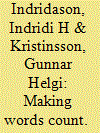| Srl | Item |
| 1 |
ID:
105709


|
|
|
|
|
| Publication |
2011.
|
| Summary/Abstract |
Party ideology plays an important role in determining which government coalitions form. Research on coalition formation tends to focus on the ideological distance between coalition parties. However, the distribution of preferences within the coalition, and the legislature, also has implications for which government coalition forms - that is, a party's willingness to join a coalition depends not only on its prospective coalition partners, but also on the alternative coalitions it could form. Several hypotheses about the effects of legislative polarisation are offered and tested using data on coalition formation in 17 parliamentary democracies in the postwar period. This article also demonstrates how the traditional measure of ideological divisions within coalitions fails to capture certain aspects of ideological heterogeneity within the cabinet (and the opposition) and how Esteban and Ray's polarisation index helps in addressing these deficiencies.
|
|
|
|
|
|
|
|
|
|
|
|
|
|
|
|
| 2 |
ID:
123013


|
|
|
|
|
| Publication |
2013.
|
| Summary/Abstract |
The cabinet is a central actor in policy making in parliamentary systems. Yet, relatively little is known about how coalition cabinets operate. The delegation of decision-making authority to ministers invites policy drift, which threatens the cohesiveness of the cabinet's policy programme. Cabinets employ a variety of methods to contain policy drift. The writing of coalition agreements is among the major tools, but there are others, including limiting ministerial autonomy and the use of junior ministers to shadow ministers. The present study demonstrates that coalition agreements are written to contain policy drift and that it is directly related to the degree of hierarchy in the cabinet. It studies the factors that affect the likelihood of a coalition agreement being written and how extensive they are, if written. Among these are the ideological diversity found in the cabinet, the use of alternative methods for controlling ministers and the complexity of the bargaining situation.
|
|
|
|
|
|
|
|
|
|
|
|
|
|
|
|